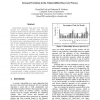Free Online Productivity Tools
i2Speak
i2Symbol
i2OCR
iTex2Img
iWeb2Print
iWeb2Shot
i2Type
iPdf2Split
iPdf2Merge
i2Bopomofo
i2Arabic
i2Style
i2Image
i2PDF
iLatex2Rtf
Sci2ools
ICST
2009
IEEE
2009
IEEE
Seasonal Variation in the Vulnerability Discovery Process
Vulnerability discovery rates need to be taken into account for evaluating security risks. Accurate projection of these rates is required to estimate the effort needed to develop patches for handling vulnerabilities discovered. Seasonal behaviors of the vulnerability discovery process for a multi-year life-cycle of software products are examined. A careful inspection of the data for several major operating systems, web servers and web browsers suggests presence of a seasonal behavior that is not considered by the vulnerability discovery models. This paper examines the statistical significance of the annual seasonal pattern in the vulnerability discovery rates using the seasonal index approach. The autocorrelation function is used to identify the periodicity. A time series analysis that combines the longer term trends with cycles caused by seasonality may predict the future pattern more accurately. The analysis of the datasets for eight major operating systems and four web related soft...
Annual Seasonal Pattern | ICST 2009 | Software Engineering | Vulnerability Discovery | Vulnerability Discovery Rates |
| Added | 24 May 2010 |
| Updated | 24 May 2010 |
| Type | Conference |
| Year | 2009 |
| Where | ICST |
| Authors | HyunChul Joh, Yashwant K. Malaiya |
Comments (0)

